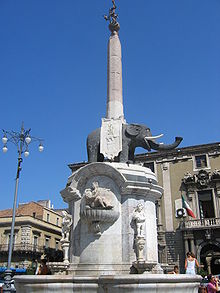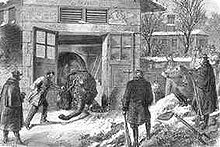- Cultural depictions of elephants
-
- See also Elephant
 The founder of the Indo-Greek Kingdom in Bactria, Demetrius I (205-171 BC), wearing the scalp of an elephant, symbol of his conquest of India[citation needed].
The founder of the Indo-Greek Kingdom in Bactria, Demetrius I (205-171 BC), wearing the scalp of an elephant, symbol of his conquest of India[citation needed].
Contents
Religion and philosophy
- The scattered skulls of prehistoric pygmy elephants on Crete, and near Catana, Sicily, featuring a single large nasal cavity at the front, may have formed the basis of belief in existence of cyclops, the one-eyed giants featured in Homer's Odyssey.
- A white elephant is considered holy in Thailand.
- Elephants are used in festivals in Sri Lanka, such as the Esala Perahera.
- Temple elephant
- Guruvayur Keshavan famous temple elephant in Kerala, India
- The story of the blind men and an elephant was written to show how reality may be viewed by different perspectives. Its source is unknown, but it appears to have originated in India. It has been attributed to Buddhists, Hindus, Jainists, and Sufis, and was also used by Discordians.
 Eleazar Maccabeus kills the war elephant and is crushed under it (Miniature from a manuscript Speculum Humanae Salvationis).
Eleazar Maccabeus kills the war elephant and is crushed under it (Miniature from a manuscript Speculum Humanae Salvationis).
 Ganesha, Basohli miniature from circa 1730.
Ganesha, Basohli miniature from circa 1730.
- Ganesh or Ganesha, the Hindu god of wisdom and one of the most popular gods in this religion's pantheon, is very distinctive in having the head of an elephant. As reconted in the Hindu sources, this was put on instead of the human head with which he was born and which was cut off or burned (there are various versions).
- In Judeo-Christian accounts, including Midrash on the sixth chapter of the apocryphal book of 1 Maccabees, the youngest of the Hasmonean brothers, Eleazar the Maccabee stuck a spear under the foot of a war elephant carrying an important Seleucid general, killing the elephant and the general at the cost of Eleazar's own life.
- In Islamic tradition, the year 570, when the Prophet Muhammad was born, is known as the Year of the Elephant. In that year, as recounted in the Muslim sources, Abraha, ruler of Yemen (most likely a viceroy for the Axumite Empire of Ethiopia), sought to conquer Mecca and demolish the Kaaba, reportedly in retaliation for the previous Meccan defilement of a cathedral Abraha had constructed in Sana'a. He launched an expedition of forty thousand men, led by a white elephant named Mahmoud (and possibly with other elephants - some accounts state there were several elephants, or even as many as eight)[1][2]). However, his design was foiled when Abraha's elephant reportedly refused to cross the boundary of Mecca and sat down. It could not be persuaded otherwise, either by reason or violence. The accounts state that if the elephant was turned towards Syria or Yemen it would walk without hesitation, but when it was turned towards the Kaaba it would kneel on its knees as if it would adore the city that its master was intent on destroying. "Al-Fil" ("The Elephant") - 105th Sura (chapter) of the Koran - commemorates this event with the verse: "Hast thou not observed how thy Lord dealt with the owners of the Elephant? Did He not bring their stratagem to nought?"
Politics and secular symbolism
 Caparisoned elephants during Sree Poornathrayesa temple festival Thrippunithura in Kerala, south India.
Caparisoned elephants during Sree Poornathrayesa temple festival Thrippunithura in Kerala, south India.
- The Elephants of Kerala are an integral part of the daily life in Kerala, South India.[3] These Indian elephants are loved, revered, groomed and given a prestigious place in the state's culture.[4] Elephants in Kerala are often referred to as the 'sons of the sahya.' The elephant is the state animal of Kerala and is featured on the emblem of the Government of Kerala.(See Elephants in Kerala culture.)
- After Alexander's victory over the Indian king Porus, the captured war elephants became a symbol of imperial power, used as an emblem of the Seleucid diadoch empire, e.g. on coins.
- The elephant, and the white elephant (also a religious symbol of the Buddha) in particular, has often been used as a symbol of royal power and prestige in Asia; occurring on the flag of the kingdom Laos (three visible, supporting an umbrella, another symbol of royal power) till it became a republic in 1975, and other Indochinese and Thai realms had also displayed one or more white elephants.
- The Order of the Elephant (Danish: Elefantordenen) is the highest order of Denmark, instituted in its current form on 1693 by King Christian V. The collar of the order consists of alternating elephants and towers, and its badge shows an elephant bearing a watch tower, in front of which a Moor is sitting, holding a golden spear.
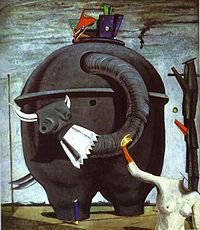 "The Elephant Celebes", well-known depiction of "A Mechanical Elephant" in a 1921 painting by the German Dadaist and Surrealist Max Ernst.
"The Elephant Celebes", well-known depiction of "A Mechanical Elephant" in a 1921 painting by the German Dadaist and Surrealist Max Ernst.
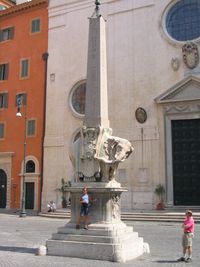 The Pulcino della Minerva, a famous Gian Lorenzo Bernini elephant sculpture, a base supporting one of the eleven Egyptian obelisks in Rome (in Piazza della Minerva).
The Pulcino della Minerva, a famous Gian Lorenzo Bernini elephant sculpture, a base supporting one of the eleven Egyptian obelisks in Rome (in Piazza della Minerva).
- The city of Catania, Sicily has an elephant coat of arms, part of the city's immemorial connection with this animal. Well-preserved remnants of dwarf elephants/elephas falconeri had been found in the Catana area, from prehistoric times up to the present. The local sorcerer Heliodorus, in Classic Greek times, was credited with either riding a magic elephant or transforming himself into this animal. Under Medieval Arab rule Catania was known as Balad-Al-Fil or Medinat-Al-Fil (Country/City of the Elephant). The symbol of the city is the Fontana dell'Elefante (Fountain of the Elephant - see image), assembled in its present form in 1736 by Giovanni Battista Vaccarini, but including a far older lavic elephant - considered to be a prehistorical sculpture reforged in the Byzantine Era.
- In Shatranj - the Medieval game from which Chess developed - the piece corresponding to the modern bishop was known as Pill or Alfil ("Elephant" in, respectively, Persian and Arabic). In the Indian Chaturanga game the piece is also called "Elephant" (Gaja). The same is true in Chinese chess which has an elephant piece ("Xiàng", 象), and the move of blocking this piece is known as "blocking the elephant's eye". In the Japanese Shogi version, the piece used to be known as the "Drunken Elephant"; it was, however, dropped by order of the Emperor Go-Nara and no longer appears in the version played in contemporary Japan. Even with modern Chess, the word for the bishop is still Alfil in Spanish, Alfiere in Italian Feel in Persian and "Elephant" (Слон) in Russian. As all these games were originally a kind of simulation of a battlefield, the piece was evidently intended to represent a war elephant. In the present-day canonical chessmen (Staunton chess set), the piece's deep groove, which originally represented the elephant's tusks, is now regarded as representing a bishop's (or abbot's) mitre.
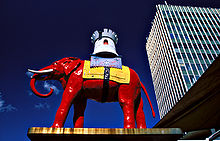 Elephant & Castle statue, London.
Elephant & Castle statue, London.
- The "Elephant and Castle" or in short "The Elephant" is a well known name in the geography and popular culture of London - being officially the name of a major road intersection and a London Underground station and unofficially used for the entire surrounding district, largely displacing its official name (Newington, London). The name is supposedly derived from a vision that someone had on London Bridge when they saw an elephant with a castle on its back in the clouds. A pub of this name had continually existed in the area since at least 1765, when a manorial Court Leet had met there - though the pub was several times demolished and rebuilt. The name of the North American Elephant and Castle Pub and Restaurant chain is derived from the British name.
- Elephanta Island (also called "Gharapuri Island") in Mumbai Harbour was given this name by 17th century Portuguese explorers who saw a monolithic basalt sculpture of an elephant near the entrance to what became known as the Elephanta Caves. The Portuguese attmpted to take it home with them but ended up dropping it into the sea because their chains were not strong enough. Later, the British moved this elephant to the Victoria and Albert Museum (now Dr Bhau Daji lad Museum) in Mumbai [5]
- The killing and eating of the elephants Castor and Pollux during the 1870 Siege of Paris got considerable attention at the time and later, and became emblematic of the hardships and degradation caused by siege and war - especially since previous to the war, the two elephants were highly popular with the Parisian public.
Political Parties with an elephant emblem
 1874 Thomas Nast cartoon featuring the first notable appearance of the Republican Party's elephant[6]
1874 Thomas Nast cartoon featuring the first notable appearance of the Republican Party's elephant[6]
The elephant as the symbol for the Republican Party of the United States originated in an 1874 cartoon of an Asian elephant by Thomas Nast of Harper's Weekly (Nast also originated the donkey as the symbol of the Democratic Party).
Popular culture
- The phrase 'elephants never forget' refers literally to elephants supposedly having an excellent memory. The variation 'Women and elephants never forget an injury' originates from the 1904 book Reginald on Besetting Sins by british writer Hector Hugh Munro, better known as Saki.[7]
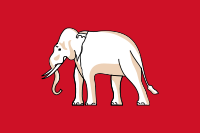 An elephant on the Thai flag of 1855-1916. The present Thai flag has no elephant, but one still appears on the country's naval ensign
An elephant on the Thai flag of 1855-1916. The present Thai flag has no elephant, but one still appears on the country's naval ensign
 Elephants on the flag of the Kingdom of Laos (1952-1975).
Elephants on the flag of the Kingdom of Laos (1952-1975).
- The expression white elephant refers to an expensive burden, particularly to a situation in which much has been invested with false expectations. The phrase 'white elephant sale' was sometimes used in Australia as a synonym for jumble sale.
- Jumbo, a circus elephant, has entered the English language as a synonym for "large".
- Elephanchine, a cartoon elephant from the Dance of the Hours segment of Walt Disneys Fantasia.
- Dumbo, the elephant who learns to fly in the Disney movie of the same name.
- The French children's storybook character Babar the Elephant (an elephant king) created by Jean de Brunhoff and also an animated TV series.
- The Oakland Athletics mascot is a white elephant. The story of picking the mascot was started when New York Giants' manager John McGraw told reporters that Philadelphia manufacturer Benjamin Shibe, who owned the controlling interest in the new team, had a "white elephant on his hands", Connie Mack defiantly adopted the white elephant as the team mascot, though over the years the elephant has appeared in several different colours (currently forest green). The A's are sometimes, though infrequently, referred to as the Elephants or White Elephants. The team mascot is nicknamed Stomper.
- The Elephant's Child is one of Rudyard Kipling's Just So Stories.
- Horton Hatches the Egg is a book by Dr. Seuss about a faithful elephant who sits on the nest of an irresponsible bird for months. (Horton would later reappear in another Seuss book, Horton Hears A Who.)
- Joseph Merrick, a British man in Victorian England was nicknamed "The Elephant Man" due to the nature and extent of his deformities.
- American band the White Stripes' fourth album was entitled Elephant, possibly because of lead singer Jack White's fondness of the animals' extreme sensitivity toward each other. The album was #390 in Rolling Stone magazine's "500 Best Albums of All Time".
- The Thai movie Tom-Yum-Goong (US title: The Protector, UK title: Warrior King) is about a man named Kham who travels from Thailand to Australia in pursuit of poachers who have stolen two elephants. Kham is a member of a family that protects the elephants of the King of Thailand. The movie was directed by Prachya Pinkaew and stars Tony Jaa.
- In J. R. R. Tolkien's The Lord of the Rings story, there exist oliphaunts, house-sized ancestors of elephants.
- The latest (2008) book by the well-known Portuguese writer José Saramago is "A Viagem do Elefante" ("The Voyage of the Elephant"), with its main protagonist being an elephant named Solomom travelling across 16th Century Europe (see [1]).
- An elephant appears on the South African 20-Rand banknotes (see South African rand).
- Jasmine, a trained elephant and companion of Lychee in the Ranma 1/2 movie Big Trouble in Nekoron, China.
- An Elephant for Aristotle is a 1958 historical novel by L. Sprague de Camp. It concerns the adventures of a Thessalian cavalry commander who has been tasked by Alexander the Great to bring an elephant captured from an Indian ruler, Porus, to Athens as a present for Alexander's old tutor, Aristotle.
- George Orwell wrote a famous essay entitled "Shooting an Elephant", chronicling a 1926 episode of being forced to shoot an elephant while he served as an Imperial Policeman in Burma.
- A famous story of Ivo Andrić is titled "A Story about the Vezier's Elephant."
- The 1985 science fiction novel "Footfall" by Larry Niven and Jerry Pournelle depicts the invasion of Earth by aliens who resemble man-sized, quadrupedal elephants with multiple trunks.
- "Seeing the Elephant" was a 19th century Americanism that pioneers and soldiers used to qualify new and exciting adventures that sometimes ended badly. Often used in regards to the Civil War, Mexican-American War, and the Oregon Trail.
See also
- Elephants in Kerala culture
- List of fictional elephants
- Francisco Scaramanga#Novel biography
- Faithful Elephants
References
- ^ Hajjah Adil, Amina, "Prophet Muhammad", ISCA, Jun 1, 2002, ISBN 1-930409-11-7
- ^ William Montgomery Watt (1974), p.7
- ^ Encyclopaedia of Indian literature vol. 1. Published by Sahitya Akademi, 1987. ISBN 8126018038. P.312
- ^ South India Handbook. Footprint Travel Guides, 2000. ISBN 1900949814. P.4
- ^ HT Cafe, Mumbai, Monday, June 4, 2007 pg.31 - Article 'Lord of the Islands" by Jerry Pinto
- ^ Cartoon of the Day: "The Third-Term Panic". Retrieved on 2008-09-01.
- ^
 English Wikiquote has quotations related to: Saki#Reginald (1904)
English Wikiquote has quotations related to: Saki#Reginald (1904)
Categories:- Elephants
- Animal worship
Wikimedia Foundation. 2010.


